前言
我们这里主要是利用requests模块和bs4模块进行简单的爬虫的讲解,让大家可以对爬虫有了初步的认识,我们通过爬几个简单网站,让大家循序渐进的掌握爬虫的基础知识,做网络爬虫还是需要基本的前端的知识的,下面我们进行我们的爬虫讲解
在进行实战之前,我们先给大家看下爬虫的一般讨论,方便大家看懂下面的实例
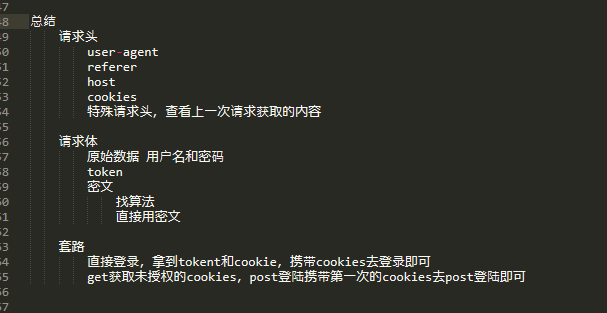
一、爬汽车之家
汽车之家这个网站没有做任何的防爬虫的限制,所以最适合我们来练手
1、导入我们要用到的模块
|
1
2
|
import requestsfrom bs4 import beautifulsoup |
2、利用requests模块伪造浏览器请求
|
1
2
|
# 通过代码伪造浏览器请求res = requests.get(https://www.autohome.com.cn/news/) |
3、设置解码的方式,python是utf-8,但是汽车之家是用gbk编码的,所以这里要设置一下解码的方式
|
1
2
|
# 设置解码的方式res.encoding = "gbk" |
4、把请求返回的对象,传递一个bs4模块,生成一个beautifulsoup对象
|
1
|
soup = beautifulsoup(res.text,"html.parser") |
5、这样,我们就可以使用beautifulsoup给我们提供的方法,如下是查找一个div标签,且这个div标签的id属性为auto-channel-lazyload-atricle
|
1
2
3
|
# find是找到相匹配的第一个标签div = soup.find(name="div",attrs={"id":"auto-channel-lazyload-article"})# 这个div是一个标签对象 |
6、findall方法,是超找符合条件的所有的标签,下面是在步骤5的div标签内查找所有的li标签
|
1
|
li_list = div.find_all(name="li") |
7、查找li标签中的不同条件的标签
|
1
2
3
4
5
6
7
8
|
li_list = div.find_all(name="li")for li in li_list: title = li.find(name="h3") neirong = li.find(name="p") href = li.find(name="a") img = li.find(name="img") if not title: continue |
8、获取标签的属性
|
1
2
3
4
5
6
7
|
# print(title, title.text, sep="标题-->")# print(neirong, neirong.text, sep="内容-->")# print(href, href.attrs["href"], sep="超链接-->") # 获取标签对接的属性# print(img.attrs["src"])# ret = requests.get(img_src) |
9、如果我们下载一个文件,则需要requests.get这个文件,然后调用这个文件对象的content方法
|
1
2
3
4
5
6
7
8
|
src = img.get("src")img_src = src.lstrip("/")file_name = img_src.split("/")[-1]img_src = "://".join(["https",img_src])print(file_name)ret = requests.get(img_src)with open(file_name,"wb") as f: f.write(ret.content) |
10、整体的代码如下
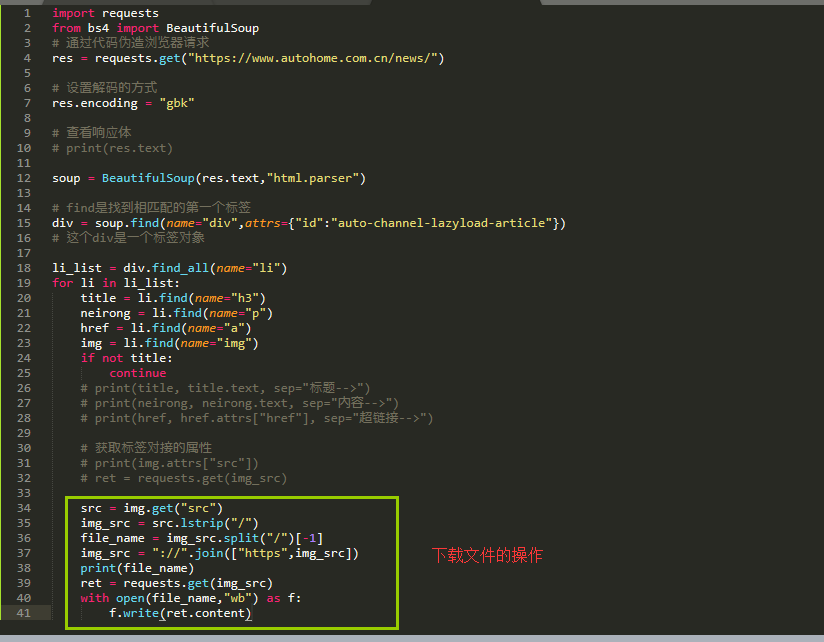
二、爬抽屉
这里我们看下如何爬抽屉
1、首先抽屉有做防爬虫的机制,我们在访问的时候必须要加一个请求头
|
1
2
3
4
5
6
|
# 实例1:爬取数据,这个网址有做防爬虫机制,所以需要带一个请求头信息,才能让服务端以为我们是浏览器,不然服务端会把我们的请求当做爬虫行为进行拦截# 设置一个请求头chouti = requests.get(url="https://dig.chouti.com/", headers={ "user-agent":"mozilla/5.0 (windows nt 6.1) applewebkit/537.36 (khtml, like gecko) chrome/57.0.2987.133 safari/537.36" }) |
2、这个请求网站会返回一个cookies,通过下面的方法获取cookies
|
1
2
|
print(chouti.cookies.get_dict())# {'gpsd': 'ab141f7a741144216429b6e901da5f34', 'jsessionid': 'aaanxwlwjllku9cgxdynw'} |
3、转换页面为一个beautifulsoup对象
|
1
2
3
4
5
6
7
8
9
|
# 将页面转换成一个beautifulsoup的对象,就可以使用beautifulsoup的方法了soup = beautifulsoup(chouti.text,"html.parser") news_list = soup.find_all(name="div",attrs={"class":"item"}) for news in news_list: compont = news.find(name="div",attrs={"class":"part2"}) print(compont.get("share-title")) |
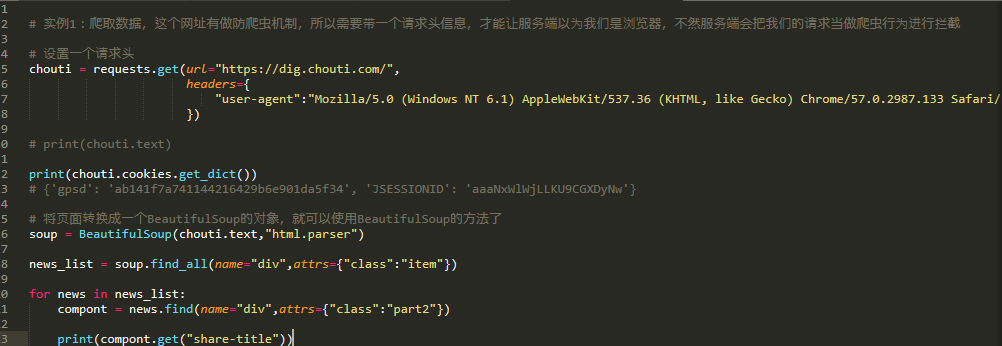
4、下面我们看下如何登陆抽屉
首先我们先通过get方式访问主页
|
1
2
3
4
5
|
# 1、先查看首页r1 = requests.get(url="https://dig.chouti.com/", headers={ "user-agent":"mozilla/5.0 (windows nt 6.1) applewebkit/537.36 (khtml, like gecko) chrome/57.0.2987.133 safari/537.36" }) |
然后我们通过post方式进行登陆,
|
1
2
3
4
5
6
7
8
9
10
11
12
13
|
# 2、提交用户名和密码进行登陆 r2 = requests.post(url="https://dig.chouti.com/login", headers={ "user-agent":"mozilla/5.0 (windows nt 6.1) applewebkit/537.36 (khtml, like gecko) chrome/57.0.2987.133 safari/537.36" }, data={ "phone":"86139252938822", "password":"admin", "onemonth":1 }, cookies=r1.cookies.get_dict() ) |
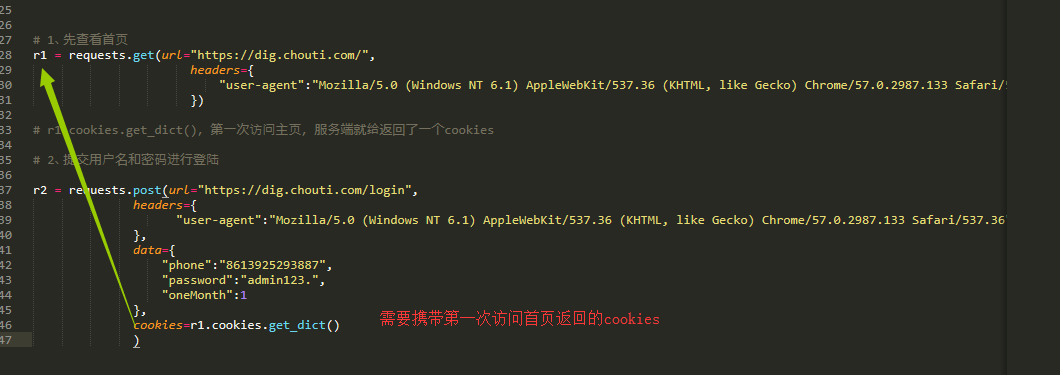
最后登陆成功后,我们来实现一个点赞的操作,这里要注意
|
1
2
3
4
5
6
7
8
9
10
11
12
13
14
15
16
17
18
19
|
# 第二次登陆的时候把第一次返回的cookies带上,这个是抽屉这个网站的套路,同样这次登陆也会返回一个cookies,但是登陆这次返回的cookies其实是个迷惑我们的cookies,没有用# print(r2.text)# 登陆失败返回的信息:{"result":{"code":"21101", "message":"手机号或密码错误", "data":{}}}# 登陆成功返回的信息:{"result":{"code":"9999", "message":"", "data":{"complatereg":"0","destjid":"cdu_53218132468"}}} # 如果登陆成功,通过下面的方法就可以把服务端返回的cookies拿到,以后在发请求,带着cookies去就可以了print(r2.cookies.get_dict())# {'puid': 'b11ec95d3b515ae2677a01f6abd5b916', 'gpid': '01cff9a184bd427789429d1dd556f4d2'} r3 = requests.post(url="https://dig.chouti.com/link/vote?linksid=25461201", headers={ "user-agent": "mozilla/5.0 (windows nt 6.1) applewebkit/537.36 (khtml, like gecko) chrome/57.0.2987.133 safari/537.36" }, # cookies=r2.cookies.get_dict(), cookies=r1.cookies.get_dict(), # 破解抽屉coookies套路 )# 这次点赞,我们同样带的cookies是第一次登陆主页返回的cookies,而不是登陆成功后返回的cookies# print(r3.text) |

爬抽屉所有的代码如下
|
1
2
3
4
5
6
7
8
9
10
11
12
13
14
15
16
17
18
19
20
21
22
23
24
25
26
27
28
29
30
31
32
33
34
35
36
37
38
39
40
41
42
43
44
45
46
47
48
49
50
51
52
53
54
55
56
57
58
59
60
61
62
63
64
65
66
67
|
# 实例1:爬取数据,这个网址有做防爬虫机制,所以需要带一个请求头信息,才能让服务端以为我们是浏览器,不然服务端会把我们的请求当做爬虫行为进行拦截 # 设置一个请求头chouti = requests.get(url="https://dig.chouti.com/", headers={ "user-agent":"mozilla/5.0 (windows nt 6.1) applewebkit/537.36 (khtml, like gecko) chrome/57.0.2987.133 safari/537.36" }) # print(chouti.text) print(chouti.cookies.get_dict())# {'gpsd': 'ab141f7a741144216429b6e901da5f34', 'jsessionid': 'aaanxwlwjllku9cgxdynw'} # 将页面转换成一个beautifulsoup的对象,就可以使用beautifulsoup的方法了soup = beautifulsoup(chouti.text,"html.parser") news_list = soup.find_all(name="div",attrs={"class":"item"}) for news in news_list: compont = news.find(name="div",attrs={"class":"part2"}) print(compont.get("share-title")) # 1、先查看首页r1 = requests.get(url="https://dig.chouti.com/", headers={ "user-agent":"mozilla/5.0 (windows nt 6.1) applewebkit/537.36 (khtml, like gecko) chrome/57.0.2987.133 safari/537.36" }) # r1.cookies.get_dict(),第一次访问主页,服务端就给返回了一个cookies # 2、提交用户名和密码进行登陆 r2 = requests.post(url="https://dig.chouti.com/login", headers={ "user-agent":"mozilla/5.0 (windows nt 6.1) applewebkit/537.36 (khtml, like gecko) chrome/57.0.2987.133 safari/537.36" }, data={ "phone":"8613925293887", "password":"admin123.", "onemonth":1 }, cookies=r1.cookies.get_dict() ) # 第二次登陆的时候把第一次返回的cookies带上,这个是抽屉这个网站的套路,同样这次登陆也会返回一个cookies,但是登陆这次返回的cookies其实是个迷惑我们的cookies,没有用# print(r2.text)# 登陆失败返回的信息:{"result":{"code":"21101", "message":"手机号或密码错误", "data":{}}}# 登陆成功返回的信息:{"result":{"code":"9999", "message":"", "data":{"complatereg":"0","destjid":"cdu_53218132468"}}} # 如果登陆成功,通过下面的方法就可以把服务端返回的cookies拿到,以后在发请求,带着cookies去就可以了print(r2.cookies.get_dict())# {'puid': 'b11ec95d3b515ae2677a01f6abd5b916', 'gpid': '01cff9a184bd427789429d1dd556f4d2'} r3 = requests.post(url="https://dig.chouti.com/link/vote?linksid=25461201", headers={ "user-agent": "mozilla/5.0 (windows nt 6.1) applewebkit/537.36 (khtml, like gecko) chrome/57.0.2987.133 safari/537.36" }, # cookies=r2.cookies.get_dict(), cookies=r1.cookies.get_dict(), # 破解抽屉coookies套路 )# 这次点赞,我们同样带的cookies是第一次登陆主页返回的cookies,而不是登陆成功后返回的cookies# print(r3.text) |
三、爬github
github的登陆是form表单做的,所以我们在登陆github的时候需要把cookies和crsf_token都带上
1、访问github的首页
|
1
2
3
4
5
6
7
8
|
# 1、get,访问登陆页面 r1 = requests.get(url="https://github.com/", headers={ "user-agent":"mozilla/5.0 (windows nt 6.1) applewebkit/537.36 (khtml, like gecko) chrome/57.0.2987.133 safari/537.36" } )# print(r1.cookies.get_dict()) |
2、访问登陆页面,需要在隐藏的input标签中找到token,然后获取到
|
1
2
3
4
5
6
7
8
9
|
r2 = requests.get(url="https://github.com/login", headers={ "user-agent": "mozilla/5.0 (windows nt 6.1) applewebkit/537.36 (khtml, like gecko) chrome/57.0.2987.133 safari/537.36" } ) login_obj = beautifulsoup(r2.text,"html.parser") token = login_obj.find(name="form",attrs={"action":"/session"}).find(name="input",attrs={"name":"authenticity_token"}).get("value") |

3、post方式访问登陆页面,携带上用户名和密码,token和cookies
|
1
2
3
4
5
6
7
8
9
10
11
12
|
# 2、发送post请求,发送用户名和密码,发送的数据要不仅有用户名和密码,还要带上csrf token和cookie,浏览器发什么,我们就发什么r3 = requests.post(url="https://github.com/session", headers={ "user-agent": "mozilla/5.0 (windows nt 6.1) applewebkit/537.36 (khtml, like gecko) chrome/57.0.2987.133 safari/537.36" }, data={ "login":"admin", "password":"admin", "authenticity_token":token }, cookies=r2.cookies.get_dict() ) |
4、以后就可以携带r3这个请求访问的cookies进行登陆github后的操作了
|
1
2
3
4
5
6
7
8
9
10
11
|
obj = beautifulsoup(r3.text,"html.parser") # print(obj.find_all(name="img",attrs={"alt":"@admin"})) # 3、发送get请求,访问这个路径:https://github.com/settings/profile r4 = requests.get(url="https://github.com/settings/profile", cookies=r3.cookies.get_dict() ) print(r4.text) |
爬github的所有的代码如下
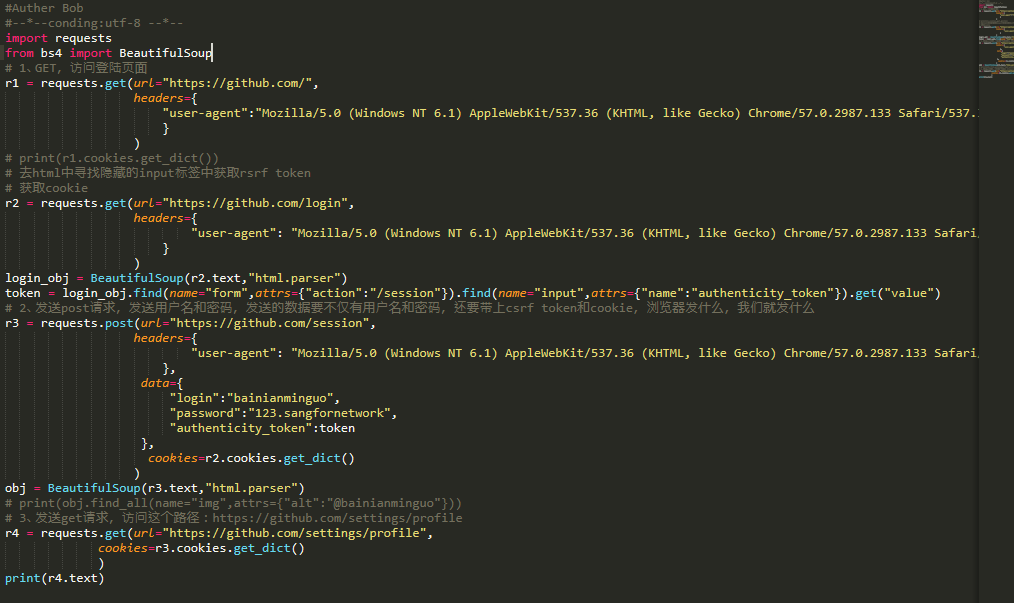
四、爬拉钩网
最后我们来爬一下拉勾网
1、首先get方式访问拉勾网的首页
|
1
2
3
4
5
6
7
8
9
10
11
12
13
14
|
import requestsfrom bs4 import beautifulsoup # 如果遇到登陆的密码被加密了有两种解决办法# 1、获取他的加密方式,然后手动破解# 2、直接抓包把加密后的数据发过去就可以了 # 1、访问登陆页面l1 = requests.get(url="https://passport.lagou.com/login/login.html", headers={ "user-agent": "mozilla/5.0 (windows nt 6.1) applewebkit/537.36 (khtml, like gecko) chrome/57.0.2987.133 safari/537.36" }) # print(l1.text) |
2、登陆拉钩网,他的请求头稍微有点特殊
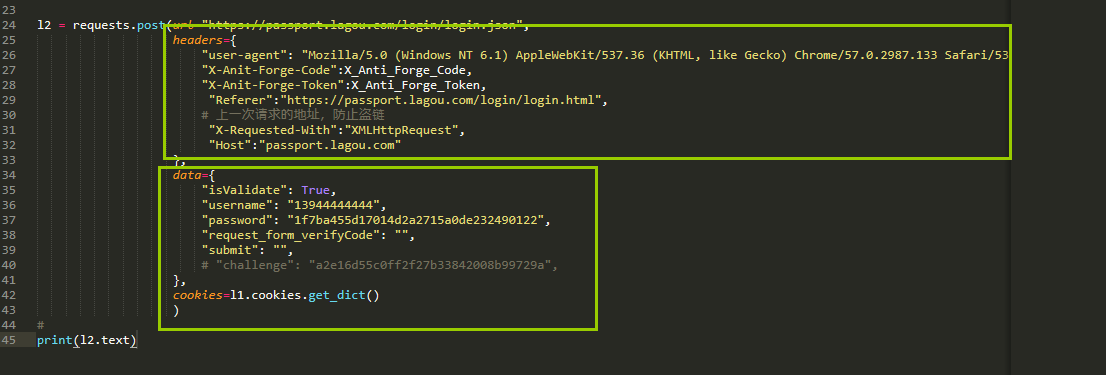
data很简单,我们直接抓包就可以拿到
主要是请求头中的数据是怎么来的,下面这2个是在我们请求登陆的页面中返回的,由于这2项在script标签中,我们只能通过正则表达式来匹配获取
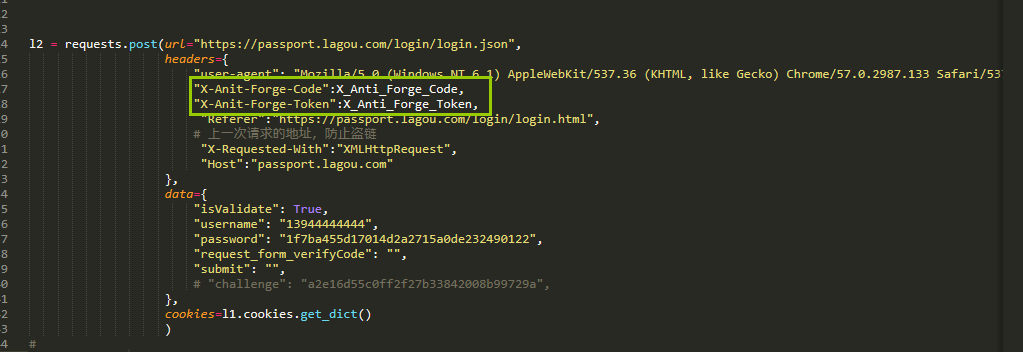


最后是爬拉勾网的所有的代码
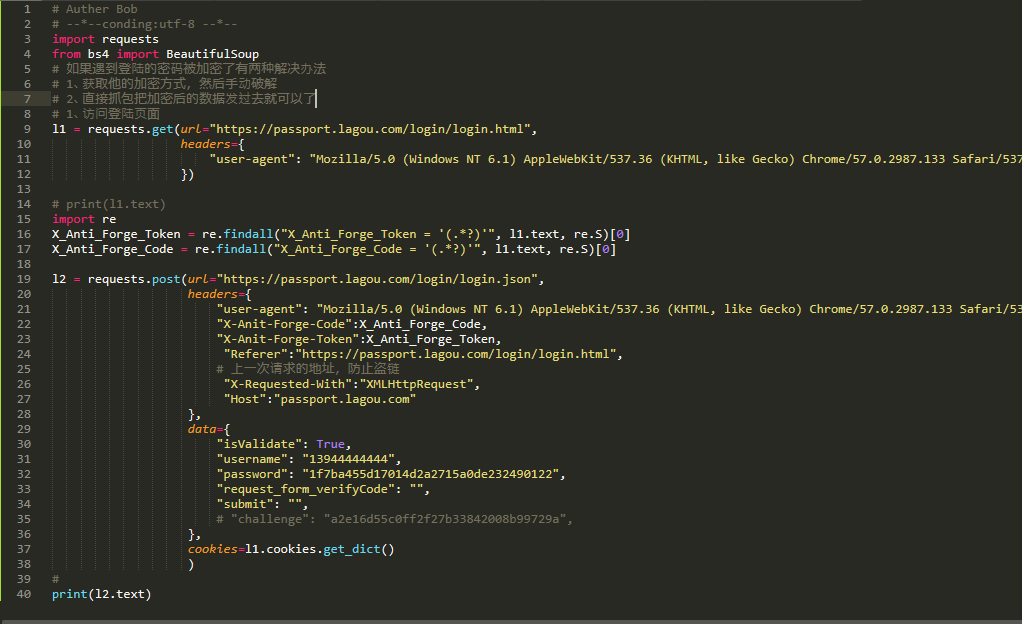
以上所述是小编给大家介绍的python爬虫系列之初识爬虫详解整合,希望对大家有所帮助,如果大家有任何疑问请给我留言,小编会及时回复大家的。在此也非常感谢大家对服务器之家网站的支持!
原文链接:https://www.cnblogs.com/bainianminguo/p/10660560.html









